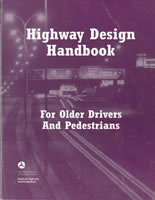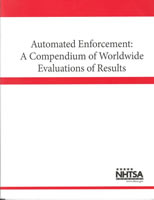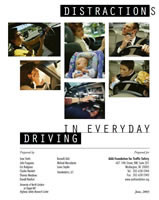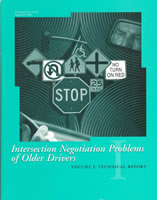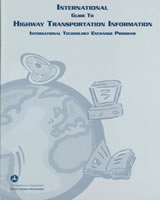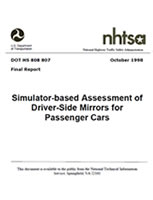Human Factors and Highway Safety
The human element must always be taken into account in the design and operation of streets and highways. Our most severe safety problems occur at intersections, where demands on drivers’ vision, attention, reactions, judgment and decision-making are the highest. But signs, signals, and pavement markings that can be easily seen and understood at a glance by our entire driving population—including the fastest growing segment, those 75 and older—are important everywhere. Highway design and engineering professionals rely on sound human factors research to ensure that infrastructure investments provide their intended benefits for all taxpayers, drivers and pedestrians alike.
The accomplishments of TransAnalytics staff in this business area span decades. Measuring the visibility, conspicuity, and legibility of highway signing and delineation; determining message characteristics that will avoid information overload; identifying the most important sources of driver distraction; and observing and analyzing driver behavior in laboratory, simulator, field, and instrumented vehicle studies—our company’s experience and qualifications reflect expertise in each of these subspecialties. A crosscutting focus on design for an aging population of road users is a particular strength; we have gained national and international recognition for the contributions our research products have made in this area.
Highway Design Handbook for Older Drivers and Pedestrians
Loren Staplin, Kathy H. Lococo, Stanley R. Byington and David Harkey
This project updated, revised, and expanded the scope of the Older Driver Highway Design Handbook published by FHWA in 1998 to provide practical guidance to engineers to accommodate the needs and functional limitations of an aging population of road users. Included recommendations are directed toward new construction, reconstruction, scheduled maintenance, and ‘spot treatments’ to ameliorate demonstrated safety problems, emphasizing countermeasures with modest additional cost during installation and the potential for cost savings over the life cycle.
This document incorporates new research findings and technical developments; extensive feedback from state, county, and municipal engineers who reviewed and applied recommendations from the earlier version of the Handbook; and recommendations with supporting background material for aspects of modern roundabouts and highway-rail grade crossings, two elements which were not covered in the 1998 publication. Recommendations geared to use of highway facilities by pedestrians also receive greater emphasis. Guidance on how and when to implement the included recommendations has been added, as well as codes which indicate at a glance the relationship of each recommendation with standard design manuals including the MUTCD and the AASHTO Green Book.
A condensed document, Guidelines and Recommendations to Accommodate Older Drivers and Pedestrians (FHWA-RD-01- 051) was also developed in this project; plus printed and electronic materials supporting the conduct of workshops with State and local practitioners throughout the U.S.
This work was performed for the Federal Highway Administration; Office of Research, Development, and Technology; 6300 Georgetown Pike; McLean, VA 22101.
To access this report, please visit the following url:
http://www.fhwa.dot.gov/publications/research/safety/humanfac/01103/
Automated Enforcement: a Compendium of Worldwide Evaluations of Results
Lawrence E. Decina, Libby Thomas, Rhagavan Srinivasan and Loren Staplin
This compendium details automated enforcement systems (AES) implemented around the world and characterizes the safety impacts of such deployments, based on available scientific evaluations of the outcome measures. Two AES technologies were highlighted: speed camera and red light camera (RLC) enforcement systems.
For automated speed enforcement, key studies reported significant reductions in estimated crashes following program implementation, but only a few studies were well-controlled. The degree to which reported safety improvements are related to the treatment and desired behavioral change (decrease in speeds) as opposed to regression to the mean (RTM), other confounders, and behavior changes such as choosing alternate routes, cannot be stated with certainty. Speed reductions documented in about half of the studies provided support for a relationship between the treatments and crash reductions. The intensity of mobile enforcements, site-specific differences (e.g. sample area, roadway characteristics), and statistical anomalies may play a role in AES effects.
For red light running enforcement, the key studies support the assertion that RLCs can reduce crash severity at high red light running intersections. Consistent with previous reports, this review attributes a decrease in right-angle crashes with an increase in rear-end crashes to RLC implementations, together with a decrease in red light running violations.
This work was performed for the National Highway Traffic Safety Administration; Office of Research and technology; 1200 New Jersey Avenue, S.E.; Washington, DC 20590.
To access this report, please visit the following url:
http://www.nhtsa.dot.gov/staticfiles/DOT/NHTSA/Traffic Injury Control/Articles/Associated Files/HS810763.pdf
A Traffic Tech summary is available at:
http://www.nhtsa.dot.gov/portal/site/nhtsa/… (shortened)
Distractions in Everyday Driving
Jane Stutts, John Feaganes, Eric Rodgman, Charles Hamlett, Thomas Meadows, Donald Reinfurt, Kenneth W. Gish, Michael Mercadante, and Loren Staplin
In the first such study of its kind, researchers used in-car video cameras to see how drivers behaved when they were behind the wheel of their own cars. Subjects were 70 paid volunteers, equally distributed by sex and age. Half were from Pennsylvania and the other half from North Carolina. The video showed that distraction is an everyday occurrence: over three hours of driving, all of the drivers were distracted at some point, 90% by something outside the car and 100% by something inside the vehicle. Approximately one-third of subjects used a cell phone while driving. Forty percent engaged in reading or writing. Child passengers were about four times, and infants about eight times, more likely to cause distraction than adult passengers. Drivers were engaged in some form of potentially distracting activity up to 16.1% of the total time their vehicles were moving.
There were two phases in this research project. Phase 1 applied data mining techniques to discover the relationship between driver inattention and motor vehicle accidents, using data from the Fatality Analysis Reporting System of the National Highway Traffic Safety Administration from years 2000 to 2003. Results suggested that when inattention and physical/mental conditions take place at the same time, the driver has a higher tendency of being involved in a collision with a static object. The instrumented vehicle study was Phase 2.
TransAnalytics supported the University of North Carolina, Highway Safety Research Center in carrying out this work for the AAA Foundation for Traffic Safety; 607 14th St., N.W., Suite 201; Washington, DC 20005.
To access this report, please visit the following url:
http://www.aaafts.org/projects/index.cfm?button=CompletedProjects#driverbehavior
Intersection Negotiation Problems of Older Drivers
Loren Staplin, Kathy H. Lococo, A. James McKnight, A. Scott McKnight, and Germaine L. Odenheimer
This project included a background literature synthesis and observational field study. The research goals were to document driving problems and errors at intersections, for older drivers using their own cars to travel familiar and unfamiliar routes, and to measure how well they could be predicted by prior tests given in an office setting. Volume I presents the field study methodology and results; Volume II presents the background synthesis.
Field observations of intersection negotiation were conducted using 82 subjects, age 61 and older, referred to the California DMV for special testing. The subjects first completed a functional test battery measuring vision, attention capabilities, and head/neck flexibility, then underwent on-road testing by DMV examiners. The on-road test was administered on both an unfamiliar and a familiar route. A miniature, multiple-camera apparatus in the driver’s own vehicle recorded visual search behaviors, brake and accelerator use, and traffic events in the forward scene.
Analysis of the videotaped data revealed a high incidence of visual search errors. Many common behaviors were included (such as failure to look to the sides when traveling through an intersection on a green light) that were technical errors, but which rarely require an emergency response. The highest error rate for an actual maneuver was making a lane change with an unsafe gap. This problem was exaggerated on the low familiarity test route.
Analysis of errors recorded by the DMV examiners followed the same general pattern as the video-based error classification, where scanning errors predominated across both familiar and unfamiliar test routes, and maneuver errors occurred less frequently. Regression analyses examined the relationships between functional test results and weighted examiners’ error scores. Speed of response on visual discrimination tasks was the best predictor, but no single measure accounted for more than 18% of variance on the criterion.
This work was performed for the National Highway Traffic Safety Administration; Office of Research and Traffic Records; 1200 New Jersey Avenue, S.E.; Washington, DC 20590.
To access this report, please visit the following url:
http://www.nhtsa.dot.gov/people/injury/olddrive/oldvol1/vol1tablecontent.html
International Guide to Highway Transportation Information
Lawrence E. Decina and Kathy H. Lococo
This is a compilation of a multi-volume set of Guides that provides highway transportation information resources for domestic and international professionals. The Guides are useful for the traffic engineer, transportation planner, and intelligent transportation systems specialist, as well as academics, applied researchers, administrative officials, and highway transportation information and library professionals. The Guides are also useful for civil engineers or other professionals in highway construction, operations, and materials; as well as highway safety and human factors engineers; psychologists; and social scientists.
Information sources for member countries of the Organization for Economic Cooperation and Development (OECD) and other selected countries are included in the Guides. The list of countries includes: Argentina, Australia, Austria, Belgium, Brazil, Canada, Chile, Czech Republic, Denmark, Finland, France, Germany, Greece, Hungary, Iceland, Ireland, Italy, Japan, Luxemburg, Mexico, Netherlands, New Zealand, Norway, Poland, Portugal, South Africa, South Korea, Spain, Sweden, Switzerland, Turkey, United Kingdom, and United States. This document is organized by chapters that correspond to the following volumes: Volume 1 – Highway Transportation Libraries and Information Centers; Volume 2 – Websites; Volume 3 – Document Delivery Suppliers; Volume 4 – Bibliographic and Non-Bibliographic Database Producers; and Volume 5 – Highway Transportation Associations, Organizations, and Other Professional Societies.
This work was performed for the Federal Highway Administration; Office of International Programs; 1200 New Jersey Avenue, S.E.; Washington, D.C. 20590.
To access this report (by individual volume), please visit the following url:
http://www.international.fhwa.dot.gov
This report is also available as FHWA-PL-01-017 through the National Technical Information Service, Springfield, VA 22161.
Simulator Based Assessment of Driver-Side Mirrors for Passenger Cars
Loren Staplin, Kathy H. Lococo, A. James J. Sim, and Kenneth W. Gish
This project included an empirical comparison of four alternative driver’s side rear view mirror designs to the standard planar mirror. Primary independent variables were field-of-view and image distortion, plus driver age. In a repeated-measures design, subjects in a laboratory fixed base simulator (an actual vehicle cab) used each mirror type to make judgments as 1) a stationary observer at the end of a ramp waiting to merge with traffic, and 2) a moving observer in a dynamic simulation of a lane-change maneuver on a freeway. Subjective measures of user acceptance of the alternative mirror designs were also obtained.
Results indicated significant effects of mirror type and driver age on lane change decisions and decision latency. Predictable effects of driver age on response latency were observed, although performance for a 65-74 age group was closer to a middle-aged group than to the oldest (75+) aged subjects. While planar mirrors afforded the most accurate judgments for lane changes by the older drivers when an overtaking vehicle was at least 1 car length back, a spherically convex design (80-inch ROC) was most effective in providing the information drivers needed to detect a conflict vehicle in the driver’s blind spot (obstructed by B-pillar). A discussion addressed the relative merits of the competing designs, including the impact of different mirror aiming strategies and the need for training for individuals who are accustomed to planar mirrors and switch to a non-planar design.
This work was performed for the National Highway Traffic Safety Administration; Office of Crash Avoidance Research; 1200 New Jersey Avenue, S.E.; Washington, DC 20590.
To access this report, please request a copy of DOT HS 808 807 from the National Technical Information Service, Springfield, VA 22161.
